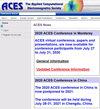用于毫米波自供电和植入式生物医学设备的单芯片双天线
IF 0.6
4区 计算机科学
Q4 ENGINEERING, ELECTRICAL & ELECTRONIC
Applied Computational Electromagnetics Society Journal
Pub Date : 2021-04-15
DOI:10.21203/RS.3.RS-332417/V1
引用次数: 1
摘要
植入式生物医学应用需要具有宽带频率通道的多波段传感器来进行射频能量收集操作。使用单独的天线进行能量收集可以简化设备电路的复杂性并减少工作频带的干扰。本文演示了一种具有两个独立集成天线的单芯片的设计,用于植入式生物医学应用。两根天线采用不同的正交极化结构,实现了低互耦和可忽略的相互作用。第一个天线是多波段弯曲线(MBML),设计用于多通道数据通信,在22-64 GHz的毫米波范围内具有四个工作频段,面积为1150 × 200μm2。第二个天线是用于射频能量收集的宽带偶极子天线(WBDA),工作频率范围为28 GHz至36 GHz,面积为1300×250μm2。该天线采用高频结构模拟器(HFSS)设计,采用UMC180nm CMOS工艺制作,总面积为0.55 mm2。MBML频段工作带宽可达2ghz,阻抗带宽≤- 10db。而WBDA天线在28ghz至36ghz的工作频带范围内有-2 dB的增益。利用人体幻象模型分别对天线的性能进行了模拟,该模型描述了人体脂肪层,并展示了它们在人体操作中的兼容性。利用晶圆探测射频微探针进行了芯片测量,并显示了仿真值与测量值之间的匹配。本文章由计算机程序翻译,如有差异,请以英文原文为准。
Single-Chip Two Antennas for MM-Wave Self-Powering and Implantable Biomedical Devices
Implantable biomedical applications arise the need for multi-band sensors with a wideband frequency channel for RF energy harvesting operation. Using a separate antenna for energy harvesting can simplify device circuit complexity and reduces operation frequency bands interference. This paper demonstrates the design of single chip with two separate integrated antennas for implantable biomedical applications. The two antennas have different structures with orthogonal polarization to achieve low mutual coupling and negligible interaction between them. The first antenna is a multi-band meander line (MBML) designed for multiple channels data communication, with quad operating bands in the MM-wave range from 22-64 GHz with area 1150 × 200μm2. The second antenna is a wideband dipole antenna (WBDA) for RF energy harvesting, operates in the frequency range extend from 28 GHz to 36 GHz with area 1300×250μm2. The proposed antennas are designed by using high frequency structure simulator (HFSS) and fabricated by using UMC180nm CMOS technology with total area 0.55 mm2. The MBML frequency bands operating bandwidths can reach 2 GHz at impedance bandwidth ≤ -10 dB. While, the WBDA antenna has gain -2 dB over the operating band extend from 28 GHz up to 36 GHz. The antenna performance is simulated separately and using the human-body phantom model that describes layers of fats inside body, and shows their compatibility for in body operation. Die measurements is performed using on wafer-probing RF PICOBROBES and shows the matching between simulation and measurement values.
求助全文
通过发布文献求助,成功后即可免费获取论文全文。
去求助
来源期刊
CiteScore
1.60
自引率
28.60%
发文量
75
审稿时长
9 months
期刊介绍:
The ACES Journal is devoted to the exchange of information in computational electromagnetics, to the advancement of the state of the art, and to the promotion of related technical activities. A primary objective of the information exchange is the elimination of the need to "re-invent the wheel" to solve a previously solved computational problem in electrical engineering, physics, or related fields of study.
The ACES Journal welcomes original, previously unpublished papers, relating to applied computational electromagnetics. All papers are refereed.
A unique feature of ACES Journal is the publication of unsuccessful efforts in applied computational electromagnetics. Publication of such material provides a means to discuss problem areas in electromagnetic modeling. Manuscripts representing an unsuccessful application or negative result in computational electromagnetics is considered for publication only if a reasonable expectation of success (and a reasonable effort) are reflected.
The technical activities promoted by this publication include code validation, performance analysis, and input/output standardization; code or technique optimization and error minimization; innovations in solution technique or in data input/output; identification of new applications for electromagnetics modeling codes and techniques; integration of computational electromagnetics techniques with new computer architectures; and correlation of computational parameters with physical mechanisms.

 求助内容:
求助内容: 应助结果提醒方式:
应助结果提醒方式:


